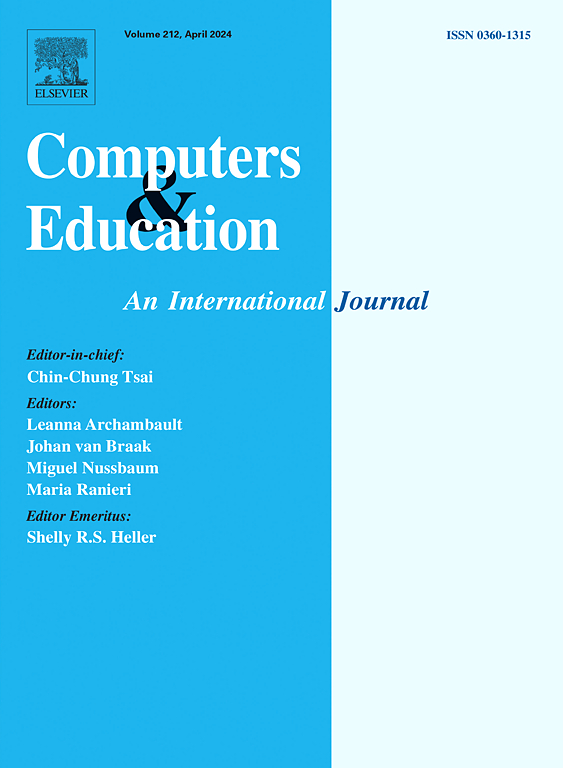Sustaining focus when It's hardest: Emotional design strengthens sustained learning, especially in contexts with attractive alternatives
IF 10.5
1区 教育学
Q1 COMPUTER SCIENCE, INTERDISCIPLINARY APPLICATIONS
引用次数: 0
Abstract
Learners increasingly use digital devices such as laptops or tablets for studying. While these devices offer advantages, they also pose challenges. They present attractive alternative opportunities for learners, such as communication or entertainment opportunities that may distract from learning. Such alternatives increase demand for self-control, particularly over time. We investigated the potential of emotional design in learning materials to support self-control by triggering and maintaining situational interest, thereby reducing the mental load required for self-control. We hypothesize that emotional design becomes especially effective in distraction-prone learning situations, such as during extended learning durations or when attractive alternative opportunities are present. We employed a 2 × 2 × 2 mixed design, varying video design (neutral vs. emotional) and opportunity presentation (no opportunity vs. opportunity presented) as between-subjects factors, and learning phase (beginning vs. end of the video) as a within-subjects factor. Our participants (N = 144) learned from a 16-min video on photography. We assessed triggered and maintained situational interest, mental load, and learning outcomes. Emotional design interacted with the learning phase, enhancing learning outcomes particularly at the end of the video. This learning benefit was mediated by the development of situational interest and a reduction in mental load. The positive impact of emotional design on learning at the end of the video was significantly stronger when an alternative opportunity was present (three-way interaction). Emotional design seems to be particularly helpful when self-control demands are high. Such conditions include extended learning sessions, the presence of attractive alternatives, or situations where multiple self-control demands come together.
在最困难的时候保持专注:情感设计可以加强持续学习,尤其是在有吸引力的选择的情况下
学习者越来越多地使用笔记本电脑或平板电脑等数字设备来学习。虽然这些设备提供了优势,但它们也带来了挑战。它们为学习者提供了有吸引力的替代机会,例如可能分散学习注意力的交流或娱乐机会。这样的选择增加了自我控制的需求,尤其是随着时间的推移。我们研究了学习材料中情绪设计的潜力,通过触发和维持情境兴趣来支持自我控制,从而减少自我控制所需的心理负荷。我们假设情绪设计在容易分心的学习环境中特别有效,比如在延长学习时间或当有吸引力的替代机会存在时。我们采用了2 × 2 × 2混合设计,不同的视频设计(中性vs情绪化)和机会呈现(没有机会vs有机会)作为受试者之间的因素,学习阶段(视频开始vs结束)作为受试者内部的因素。我们的参与者(N = 144)从一个16分钟的摄影视频中学习。我们评估了触发和维持情境兴趣、心理负荷和学习结果。情感设计与学习阶段相互作用,提高学习效果,特别是在视频结束时。这种学习效益是由情境兴趣的发展和心理负荷的减少所介导的。在视频结束时,当出现另一个机会(三方互动)时,情感设计对学习的积极影响显著增强。当自我控制要求很高时,情绪设计似乎特别有用。这些条件包括延长的学习时间,有吸引力的替代方案的存在,或者多种自我控制需求同时出现的情况。
本文章由计算机程序翻译,如有差异,请以英文原文为准。
求助全文
约1分钟内获得全文
求助全文
来源期刊

Computers & Education
工程技术-计算机:跨学科应用
CiteScore
27.10
自引率
5.80%
发文量
204
审稿时长
42 days
期刊介绍:
Computers & Education seeks to advance understanding of how digital technology can improve education by publishing high-quality research that expands both theory and practice. The journal welcomes research papers exploring the pedagogical applications of digital technology, with a focus broad enough to appeal to the wider education community.
 求助内容:
求助内容: 应助结果提醒方式:
应助结果提醒方式:


